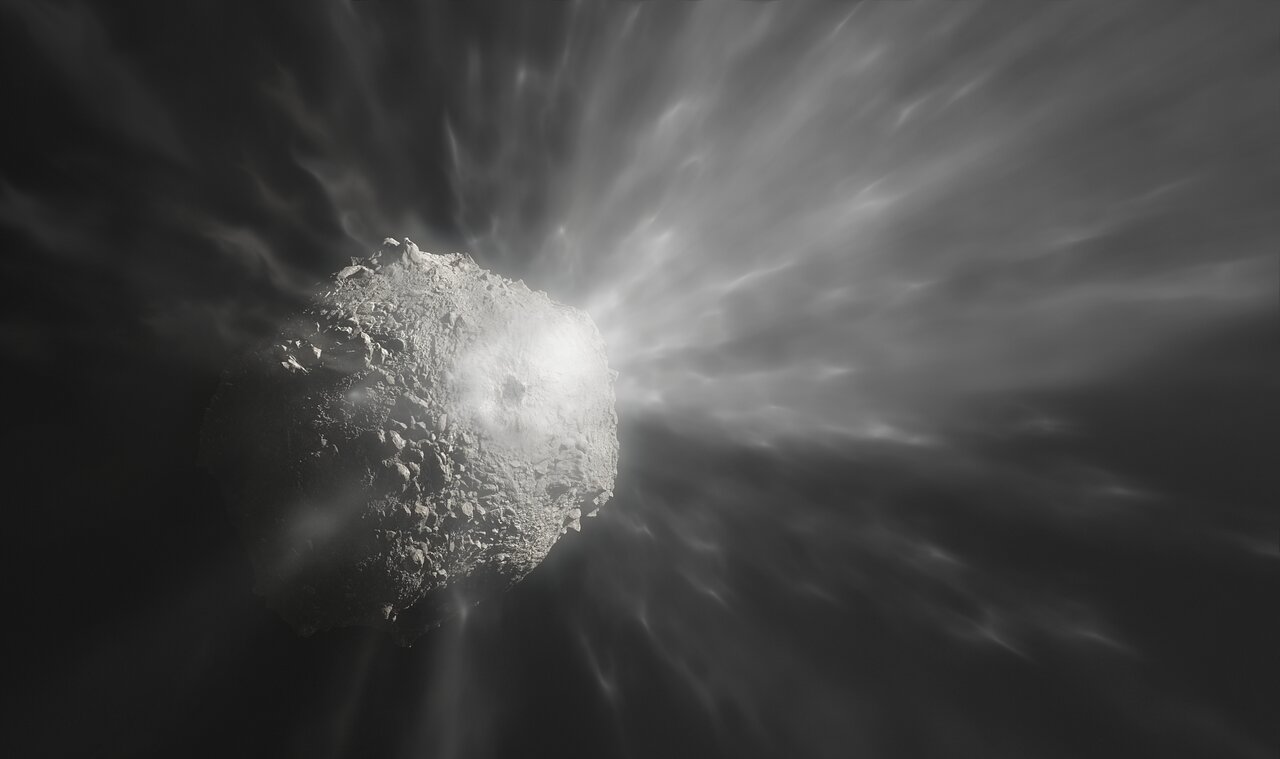When the DART spacecraft slammed into asteroid Dimorphos on September 26, 2022, telescopes worldwide (and in space) were watching as it happened. But others continued watching for numerous days afterward to observe the cloud of debris. DART’s (Double Asteroid Redirection Test) intentional impact was not only a test of planetary defense against an asteroid hitting our planet, but it also allowed astronomers the chance to study Dimorphos, a tiny moon or companion to asteroid Didymos.
New images released by the European Southern Observatory’s Very Large Telescope (VLT) show how the surface of the asteroid changed immediately after the impact when pristine materials from the interior of the asteroid were exposed. Other data tracked the debris’ evolution over a month, and provided details on how the debris changed over time. Additionally, astronomers searched for evidence of DART’s fuel but couldn’t find any.

“Impacts between asteroids happen naturally, but you never know it in advance,” said Cyrielle Opitom, an astronomer at the University of Edinburgh and lead author of one of two studies just published about the impact. “DART is a really great opportunity to study a controlled impact, almost as in a laboratory.”
All four of the 8.2-meter telescopes of the VLT in Chile observed the aftermath of the impact, which occurred when Dimorphos was 11 million kilometers away from Earth.
The first study, led by Stefano Bagnulo, an astronomer at the Armagh Observatory and Planetarium in the Northern Ireland, studied how the DART impact altered the surface of the asteroid.
“When we observe the objects in our Solar System, we are looking at the sunlight that is scattered by their surface or by their atmosphere, which becomes partially polarized,” said Bagnulo, in an ESO press release. This means that light waves oscillate along a preferred direction rather than randomly. “Tracking how the polarization changes with the orientation of the asteroid relative to us and the Sun reveals the structure and composition of its surface.”
Bagnulo and his team used the FOcal Reducer/low dispersion Spectrograph 2 (FORS2) instrument at the VLT to monitor the asteroid, and found that the level of polarization suddenly dropped after the impact. At the same time, the overall brightness of the system increased. One possible explanation is that the impact exposed more pristine material from the interior of the asteroid.
“Maybe the material excavated by the impact was intrinsically brighter and less polarizing than the material on the surface, because it was never exposed to solar wind and solar radiation,” said Bagnulo.
However, another possibility is that the impact destroyed particles on the surface, thus ejecting much smaller ones into the cloud of debris. “We know that under certain circumstances, smaller fragments are more efficient at reflecting light and less efficient at polarizing it,” said Zuri Gray, a PhD student also at Armagh.

In the second study Opitom and her team tracked the evolution of the debris cloud from the collision for a month with the Multi Unit Spectroscopic Explorer (MUSE) instrument on the VLT. MUSE allowed the astronomers to study the spectrum of chemicals and gases present in the debris. In particular, they searched for oxygen and water coming from ice exposed by the impact, but they found nothing.
“Asteroids are not expected to contain significant amounts of ice, so detecting any trace of water would have been a real surprise,” said Opitom in and ESO press release. They also looked for traces of the propellant of the DART spacecraft, but found none. “We knew it was a long shot,” she said, “as the amount of gas that would be left in the tanks from the propulsion system would not be huge. Furthermore, some of it would have travelled too far to detect it with MUSE by the time we started observing.”
As the debris expanded outward, astronomers noticed that structures started forming, such as clumps, spirals and a long tail pushed away by the Sun’s radiation. Parts of the debris started redder and shifted into blue, indicating that the solar wind pushed smaller particles away from the Sun. Other parts of the debris were redder than the initial cloud, meaning that the clumps and structures were made of larger particles that were less affected by the solar wind.
ESO said the two studies show the potential of the VLT when its different instruments work together. In fact, in addition to MUSE and FORS2, the aftermath of the impact was observed with two other VLT instruments, and analysis of these data is ongoing.
“This research took advantage of a unique opportunity when NASA impacted an asteroid,” said Opitom, “so it cannot be repeated by any future facility. This makes the data obtained with the VLT around the time of impact extremely precious when it comes to better understanding the nature of asteroids.”
Read the teams’ papers:
“Optical spectropolarimetry of binary asteroid Didymos-Dimorphos before and after the DART impact” published in Astrophysical Journal Letters (doi:10.3847/2041-8213/acb261).
“Morphology and spectral properties of the DART impact ejecta with VLT/MUSE” published in Astronomy & Astrophysics (doi:10.1051/0004-6361/202345960).

